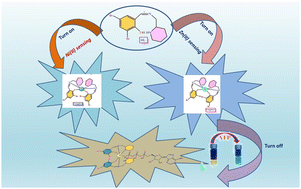Solvent-regulated fluorescence off–on signaling of Ni(ii) and Zn(ii) with the formation of two mononuclear complexes with an ATP detection ability by Zn(ii) assembly†
Abstract
The current study shows that Schiff base HL, (Z)-2,4-dibromo-6-(((piperidin-2-ylmethyl)imino)methyl)phenol, can be used successfully as a selective chemosensor for Zn(II) and Ni(II) among several competing cations in purely aqueous and semi-aqueous media. Under UV light in methanol–water (9 : 1) HEPES buffer, the receptor gives its response by changing its color to cyan color in the presence of Zn(II) and to bluish cyan color in the presence of Ni(II). Surprisingly, the chemosensor can only reliably identify Zn(II) in a hundred percent aqueous medium by changing its color to light yellow. UV and fluorescence studies in both aqueous and semi-aqueous media are used to further investigate this Zn(II) and Ni(II) recognition phenomenon. The high values of the host–guest binding constants, obtained by electronic and fluorescence titration, ensure that a strong bond exists between HL and Ni(II)/Zn(II). As anticipated, two highly luminescent mononuclear, crystalline compounds, complexes 1 and 2, have been developed by a separate reaction of HL and Zn(II)/Ni(II), and the high luminous properties are due to the occurrence of Chelation Enhanced Fluorescence (CHEF). According to the single crystal structure, the asymmetric units of both complexes consist of two deprotonated chemosensor units and one Zn(II)/Ni(II), leading to the formation of an octahedral complex. For Ni(II) and Zn(II) sensing, the predicted LOD is in the nanomolar range. Both complexes 1 and 2 are fluorescence active and studies to check their ATP detection ability, but intriguingly, only complex 2 is capable of detecting ATP in a fully aqueous solution. Finally, the live cell imaging study validates the two sensors’ biosensing functionality.



 Please wait while we load your content...
Please wait while we load your content...